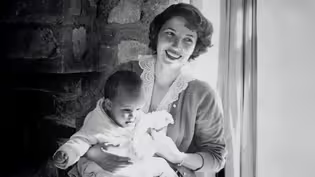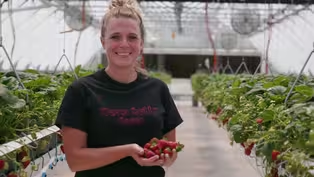
Preserving Frank Lloyd Wright's organic architecture
Clip: Season 12 Episode 2 | 3m 40sVideo has Closed Captions
Carrie Rodamaker and Caroline Hamblen on preserving Frank Lloyd Wright's Taliesin estate.
Executive Director Carrie Rodamaker and Director of Programs Caroline Hamblen discuss the ongoing preservation of Taliesin, Frank Lloyd Wright's 800-acre estate in Spring Green. Built in 1911, the property showcases Wright's organic architecture philosophy, using limestone and oak from the land.
Problems playing video? | Closed Captioning Feedback
Problems playing video? | Closed Captioning Feedback
Wisconsin Life is a local public television program presented by PBS Wisconsin
Funding for Wisconsin Life is provided by the Wooden Nickel Fund, Mary and Lowell Peterson, A.C.V. and Mary Elston Family, Stanley J. Cottrill Fund, UW Health, donors to the Focus Fund for Wisconsin Programs, and Friends of PBS Wisconsin.

Preserving Frank Lloyd Wright's organic architecture
Clip: Season 12 Episode 2 | 3m 40sVideo has Closed Captions
Executive Director Carrie Rodamaker and Director of Programs Caroline Hamblen discuss the ongoing preservation of Taliesin, Frank Lloyd Wright's 800-acre estate in Spring Green. Built in 1911, the property showcases Wright's organic architecture philosophy, using limestone and oak from the land.
Problems playing video? | Closed Captioning Feedback
How to Watch Wisconsin Life
Wisconsin Life is available to stream on pbs.org and the free PBS App, available on iPhone, Apple TV, Android TV, Android smartphones, Amazon Fire TV, Amazon Fire Tablet, Roku, Samsung Smart TV, and Vizio.
Providing Support for PBS.org
Learn Moreabout PBS online sponsorship- We're exploring Taliesin, home and studio of Frank Lloyd Wright, touring the estate and learning about their extensive restoration work.
My first stop was to the Hillside Theater to meet up with Executive Director Carrie Rodamaker, and to learn more about the history and preservation of this 800-acre estate.
- Carrie Rodamaker: Taliesin is Frank Lloyd Wright's home.
This is a place where his ancestors immigrated from Wales.
He grew to love this area, and eventually built his own home in 1911.
One of the things that Wright was doing was playing with the surrounding beauty of the land and incorporating his buildings into it.
- Beautiful, and so what does that look like in terms of how they're constructed?
- So, part of it is organic architecture.
So using natural material.
A lot of the limestone was harvested from here.
You'll see a lot of oak.
But you'll also see a lot of new materials, like plywood.
Because of all of those kind of natural materials, and this being that laboratory, that experimental place for Wright, it poses huge challenges.
It's almost like an archaeological dig, so we can understand what they were doing before we can start to figure out how do we kind of reconstruct and preserve the historic fabric, but also making it sustainable for the future.
- Angela: An example of that historic fabric is this curtain Wright designed that hangs in Taliesin's theater, where we chatted with Caroline Hamblen, Director of Programs.
- Caroline Hamblen: So the Hillside Theater just reopened last year.
It was designed by Wright to bring lectures, dance, theater, movies into the space.
And that legacy is something that we're continuing to today.
- Are there other types of programs or other opportunities that are available here?
- Absolutely.
So, we have our regular tour program.
There is four different variety of tours that you can come and engage with us May through October.
We work a lot with schools.
We love working with educators from the region, bringing their students here.
Then there is workshop opportunities, and then we have the programming of the Hillside Theater available as well.
- So lots of opportunities throughout the estate for all ages throughout the year.
- Yes, absolutely.
And that is really the goal, that is what Taliesin always has been, and that's what we want to continue into the future.
All kinds of different ages, different interests, bringing everybody here into this UNESCO World Heritage site now.
- Angela: A site that will be preserved for future generations.
From the stage... - Caroline: Now you can see how the size of the stage almost doubled.
You notice that part of the stage is built into the ground.
And that caused a lot of water infiltration issues.
- Angela: ...to the green rooms.
So this is part of the new space?
- Caroline: We've never had green rooms for the artists.
The room behind the stage used to be dirt floor.
- Angela: All to honor the world-famous architect who Carrie Rodamaker says loved Wisconsin and called it home.
- Carrie: I think we just want to celebrate Wisconsin, we wanna celebrate this place.
Celebrate Wright for growing up as a Wisconsin farm kid.
This is where he was really creating an architecture for America, and we encourage people to come and see it.
[bright music]
Art-Hop Collective brings vibrant murals to game day in Green Bay
Video has Closed Captions
Clip: S12 Ep2 | 4m 58s | Andrew Linskens is an artist creating vibrant murals with raw, imaginative storytelling. (4m 58s)
Special Olympics athlete becomes disability rights champion
Video has Closed Captions
Clip: S12 Ep2 | 4m 39s | Given 24 hours to live at birth, Cindy Bentley beat the odds. (4m 39s)
Video has Closed Captions
Clip: S12 Ep2 | 4m 55s | Minerva Montooth, 101, worked alongside Frank Lloyd Wright and wife Olgivanna. (4m 55s)
From backyard garden to high-tech strawberry farm
Video has Closed Captions
Clip: S12 Ep2 | 3m 46s | Horticulturist Erin Warner leads a hydroponic strawberry operation at Warm Belly Farm. (3m 46s)
Providing Support for PBS.org
Learn Moreabout PBS online sponsorshipSupport for PBS provided by:
Wisconsin Life is a local public television program presented by PBS Wisconsin
Funding for Wisconsin Life is provided by the Wooden Nickel Fund, Mary and Lowell Peterson, A.C.V. and Mary Elston Family, Stanley J. Cottrill Fund, UW Health, donors to the Focus Fund for Wisconsin Programs, and Friends of PBS Wisconsin.

















